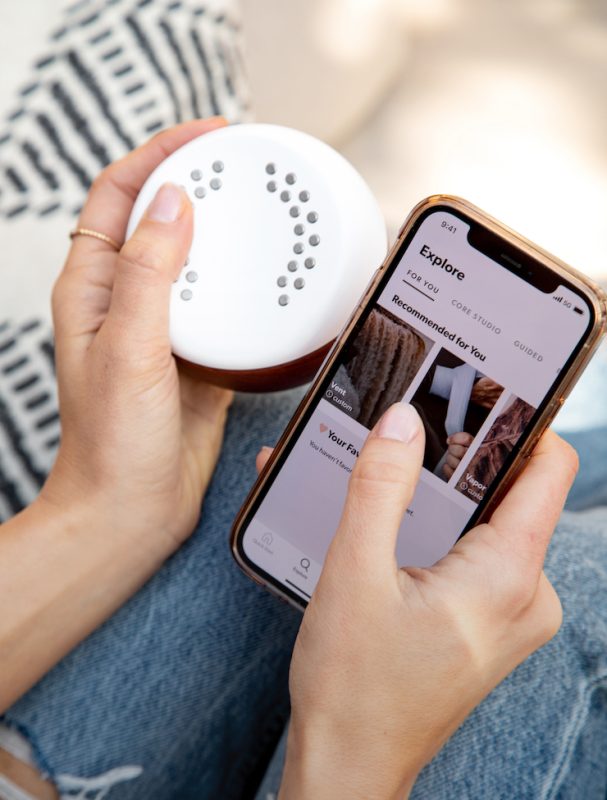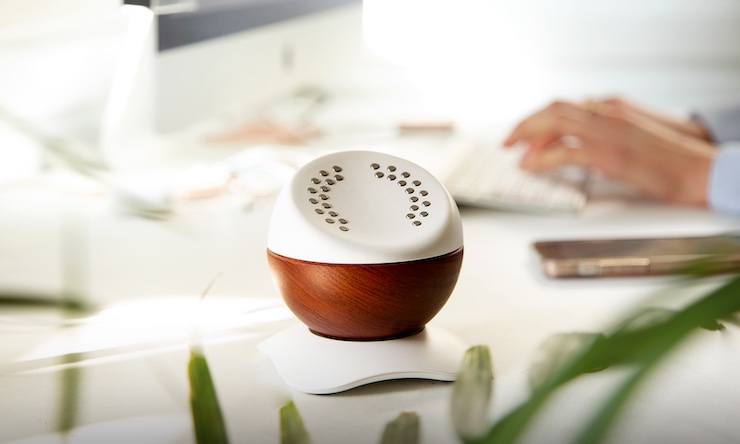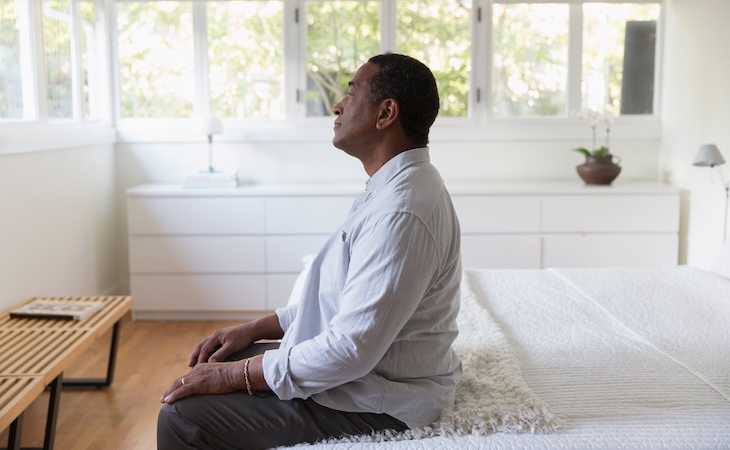Ask any fitness professional, and they’ll all tell you the same thing: If you work out a lot, then you need to save time for recovery.
Whether that’s getting a massage, upping your protein intake, or staying hydrated, all of these components help muscle soreness and build you back stronger, ready to tackle your next workout with ease.
Since I’m at a workout class almost every single day, I use a lot of Hyperice products—particularly their mini massage gun, the Hypervolt Go 2—to help me feel better fast.
However, I recently found that I wasn’t at my best when it came to my workouts, and it was because I was neglecting one of the most important aspects of my recovery: sleep.
As we all know, sleep is crucial for tons of our daily functioning, from boosting our immune systems and mental health to helping with workout recovery and increasing focus.
While I usually read a book until I’m ready to fall asleep, I noticed that in the summer, my bedtime was getting later and later (blame the extra hours of sunlight for that!).
Unfortunately, my wakeup time stayed exactly the same, and I was too tired in the morning—but too wired at night—to really do much about it.
When I asked my friends for help, many told me to meditate before I went to bed. But despite using guided meditation apps, I couldn’t get myself calm enough to go to sleep.
However, when I discovered the Core by Hyperice on the brand’s site, I knew I just had to try it. And honestly? It completely changed the game for me.

What is the Core by Hyperice?
While the Hyperice brand normally creates several tools for muscle recovery, from massage guns to compression boots, the Core is different in the sense that it doesn’t work on muscle recovery at all.
Instead, it’s a meditation tool that consists of both an app and a small, dome-like device that you hold while meditating. The Core device contains electrodes on the surface, and you hold the device while you meditate using a meditation option from the app.
Designed by founder Sarah McDevitt, the Core was created to help reduce anxiety. The company refers to it more as a meditation “trainer” than a device—aka, it’s supposed to help teach you how to meditate.
“Unlike other meditation apps, Core is both an app and a handheld meditation device designed to track heart rate and stress levels,” says Star Sage, senior director of business development at Hyperice. “The beautiful, ergonomic trainer uses its built-in electrocardiogram (ECG) and biosensors to track heart and nervous system data. Each session uses multi-sensory (vibration and lights) guidance with daily classes from expert instructors to create personalized, trackable results, where you will see your progress.”
Essentially, the Core allows you to monitor variables such as heart rate and pulse and uses gentle vibrations to guide your breathing. It also gives you a record of each session on the app when you’re done, so you can see how you’re doing as the session ends.
The purpose of the Core is to make you more aware of your breathing and heart rate while meditating, putting you in a calm, relaxed state.
How I used the Core by Hyperice
According to the brand, you can use the Core by Hyperice any time you like, but I chose to specifically use it before bed to see if it would help me fall asleep faster.
Essentially, all I did was choose a meditation from the app (I had multiple options, ranging from breathwork to fundamentals to stress relief), and then held the Core in my hands.
I was directed to make sure my thumbs were on some of the dots (sensors) while I meditated, but that’s pretty much all the instructions the manual gave me.
“Depending on the type of session, the vibrations will either guide you in breath technique training or serve as a gentle reminder to help keep your attention focused,” says Sage. “During each meditation, Core’s ECG biosensors measure your heart and nervous system. The Core app displays your biofeedback and insights to show the impact meditation has on your mental and physical wellness.”
While meditating, I could see the real difference when it came to the Core and how different it was from other meditation apps on the market.
For one, there was a constant vibration the entire time I was using it, and while I first thought the sensation would be distracting, it was actually great. Basically, the vibrations pulsate—speeding up and slowing down—all while the app tells you how many seconds to hold your breath and how long to wait between them.
This gave me something tangible to focus on, and it made me realize when I was off-track, due to the constant vibrations and reminders. This made the Core a true “training device” in my eyes. It could tell when I was distracted and not following its cues—and then, it quickly brought me back into focus.
After the meditation, I could see my stats and use them to track my progress. The app shows you a few main measures you need to pay attention to: BPM or heartbeats per minute, heart rate variability (HRV) or the time between each heartbeat, how long you were in Calm state, how long you were in Focus state, and the number of minutes you meditated (trained) overall.
There was a constant vibration the entire time I was using it, and while I first thought the sensation would be distracting, it was actually great.
According to the app, the lower your BPM, the more relaxed you are, while your HRV should be higher because that indicates higher resilience to stress.
The Calm state indicates your mind and body are at rest and your parasympathetic nervous system (responsible for the body’s rest and relaxation response) is dominant, which means you’re more likely to respond kindly to anything that’s stressing you out.
The Focus state indicates that you’re physically relaxed, but your mind is still active and engaged—and it knows this because your breath and heart rate aren’t synced together.
I found this distinction really cool because a lot of times, I thought I was meditating in the Calm state, but the stats don’t lie: I was clearly thinking about something else!
Having this awareness was great for me because it truly gave me something to focus on, and I loved the meditations offered too since there were so many options to choose from, ranging from five to 30 minutes in length.
In the span of a week when I used the Core five times, my Calm percentage went up from 35% to 52%, and my HRV went from an average of 49 to 55.
According to Sage, most Core users see an improvement in HRV within eight sessions, which automatically makes them calmer throughout the day.
I definitely noticed it was much easier for me to fall asleep on the days I used the Core, and I wasn’t cranky or moody the next day because of it. And yes—I crushed those workouts so much harder too!

Does the Core by Hyperice help sleep?
While the company doesn’t specify the Core to be used simply as a device to help sleep, I personally found the combination of deep breathing techniques and soothing meditations available helped put me in an incredibly relaxed state. This made it much easier for me to fall asleep.
While I’d tried tons of meditation apps in the past, the Core was different because it could tell immediately when I was zoning out or staying focused, and I was able to measure my heart rate using the app too.
I personally found the combination of deep breathing techniques and soothing meditations available helped put me in an incredibly relaxed state. This made it much easier for me to fall asleep.
My stress levels immediately went down after using the app, which, according to studies, can also help sleep quality. I fell asleep more easily and woke up more refreshed, which I owe to the Core by Hyperice.
Should you use a meditation device to help you sleep?
If you’re someone who gets distracted while meditating and would like some help to do so, I highly recommend trying a meditation device.
The gentle vibrations and reminder to keep focusing on your breath set them apart from other traditional meditation apps, and I personally felt like this helped me not get distracted while I meditated—something that using simpler apps or trying to meditate on my own didn’t do.
I chalk that up to the constant reminders to follow my breath, along with the calming ritual of using the device right before bed.
Here’s how to use a meditation device to your advantage
The best way to make sure a meditation device helps you achieve your goals is to use it consistently—which I know can be easier said than done!
However, studies have shown that long-term meditation can change the way your body reacts to stressors, therefore making you more resilient to the issues that trouble you on a daily basis. This means that over time, you’ll be calmer and in a more relaxed state on the daily, thereby making it easier for you to fall asleep.
You should also make sure to keep track of your progress on the device, taking note of your HRV and state per session, so that you’re aware of your resting state before bed. Your goal is to make sure your HRV keeps going up and that you’re in the Calm state longer and longer each time.
By allowing you to keep track of these tangible goals, the Core meditation device can help you see how calm you are while meditating and improve your progress.
FAQs
What is a meditation tool?
A meditation tool can be anything that’s used to increase your focus and reduce distractions while meditating—whether that’s a bolster you sit on, some sound bowls to keep your hands and brain occupied, an app that helps guide your breath, or a higher-tech device like the Core by Hyperice.
The purpose of a meditation tool is to simply make your meditation more effective for you. What works for one person may not always work for another, however, so make sure to test out the various tools available on the market to find one that works best.
What objects can help with meditation?
There are a number of different objects that can help with meditation, but here are a few of the top ones available on the market right now. Some help ground the space and body, some keep you comfortable, and still others help you tune out distractions.
See if any of the below options tickle your fancy:
- Essential oils or candles
- A bolster
- Meditation pillows
- Meditation devices and heart rate monitors
- Guided meditation videos and apps
- Sound bowls
- Crystals
- Eye pillows
- Incense
- Bead bracelets
- Shawls or blankets
- Self-set timers
What apps really work to help you snooze? Check out the best sleep apps we tried to improve our sleep.
Images courtesy of Hyperice




